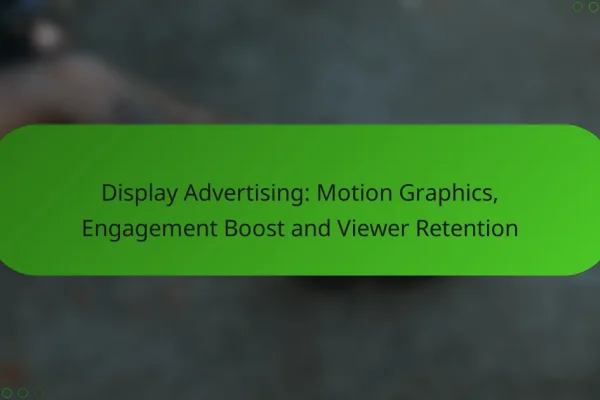What are the key elements of display advertising creative design?
The key elements of display advertising creative design include visual hierarchy, color theory, typography, imagery and graphics, and call-to-action placement. Each of these elements plays a crucial role in capturing attention and driving user engagement.
Visual hierarchy
Visual hierarchy refers to the arrangement of elements in a way that guides the viewer’s eye through the advertisement. Effective use of size, contrast, and spacing can help emphasize the most important information, making it easier for viewers to understand the message quickly.
To create a strong visual hierarchy, prioritize elements based on their importance. For instance, the headline should be the most prominent, followed by subheadings and body text. Use larger fonts and bolder colors for key messages to draw attention.
Color theory
Color theory involves understanding how colors interact and influence emotions and perceptions. Choosing the right color palette can enhance brand recognition and evoke specific feelings that align with the advertisement’s message.
When selecting colors, consider using complementary colors to create contrast or analogous colors for a harmonious look. Aim for a limited palette of two to four colors to maintain visual coherence and avoid overwhelming the viewer.
Typography
Typography is the art of arranging text in a visually appealing way. The choice of font style, size, and spacing can significantly impact readability and the overall aesthetic of the advertisement.
Use no more than two different fonts to maintain consistency. Ensure that the font size is legible across devices, typically using at least 16px for body text. Avoid overly decorative fonts that may distract from the message.
Imagery and graphics
Imagery and graphics play a vital role in display advertising by providing visual interest and supporting the message. High-quality images can capture attention and convey information quickly, while graphics can illustrate concepts or highlight features.
Choose images that are relevant to the content and resonate with the target audience. Ensure that graphics are not overly complex, as simplicity often leads to better comprehension and retention.
Call-to-action placement
The placement of the call-to-action (CTA) is critical in guiding users toward the desired action, such as clicking a link or making a purchase. A well-placed CTA can significantly improve conversion rates.
Position the CTA in a prominent location, typically near the center or bottom of the ad, and use contrasting colors to make it stand out. Phrases like “Learn More” or “Get Started” should be clear and compelling to encourage user interaction.
How can I optimize display ads for better performance?
To optimize display ads for better performance, focus on A/B testing, understanding your target audience, and analyzing ad placements. These strategies help refine your creative elements, ensuring they resonate with viewers and drive desired actions.
A/B testing strategies
A/B testing involves comparing two versions of an ad to determine which performs better. Start by changing one element at a time, such as the headline, image, or call-to-action, to isolate its impact on performance.
Track metrics like click-through rates (CTR) and conversion rates to evaluate effectiveness. Aim for a sample size that provides statistically significant results, typically in the low hundreds to thousands, depending on your audience size.
Target audience segmentation
Segmenting your target audience allows for more tailored messaging in your display ads. Use demographic data, interests, and online behavior to create distinct groups that can be targeted with specific ad variations.
Consider using tools like Google Analytics or Facebook Ads Manager to gather insights on your audience. This approach can increase engagement and conversion rates, as ads will be more relevant to each segment’s preferences.
Ad placement analysis
Analyzing ad placements is crucial for maximizing visibility and engagement. Evaluate where your ads are displayed, such as on specific websites or within certain content categories, to identify high-performing placements.
Use metrics like viewability rates and engagement levels to assess effectiveness. Regularly review and adjust your placements based on performance data, focusing on platforms that yield the best return on investment (ROI).
What design tools are best for creating display ads?
Several design tools are highly effective for creating display ads, each offering unique features and capabilities. The best choice depends on your specific needs, such as design complexity, collaboration requirements, and budget.
Adobe Creative Cloud
Adobe Creative Cloud is a comprehensive suite of design tools that includes Photoshop, Illustrator, and InDesign, making it ideal for professional-grade display ads. These applications provide advanced features for image editing, vector graphics, and layout design, allowing for high customization and precision.
When using Adobe Creative Cloud, consider your skill level and the time investment required to master the tools. Subscription costs can vary, typically ranging from $20 to $80 per month, depending on the plan you choose. This investment may be worthwhile for businesses needing high-quality, unique designs.
Canva
Canva is a user-friendly online design tool that simplifies the creation of display ads with its drag-and-drop interface. It offers a wide range of templates, images, and fonts, making it accessible for beginners and small businesses looking to create visually appealing ads quickly.
Canva operates on a freemium model, with a free version available and a Pro subscription costing around $12.99 per month. This makes it a cost-effective option for those who need basic design capabilities without the steep learning curve associated with more complex software.
Figma
Figma is a collaborative design tool that excels in creating user interfaces and display ads. Its cloud-based platform allows multiple users to work on designs simultaneously, making it ideal for teams. Figma supports vector graphics and prototyping, which can enhance the design process.
Figma offers a free tier with limited features, while the professional plan starts at about $12 per editor per month. This flexibility makes it suitable for both individual designers and larger teams looking for efficient collaboration in their ad design projects.
What are the common mistakes in display advertising design?
Common mistakes in display advertising design can significantly hinder campaign effectiveness. Key issues include poor mobile optimization, overly cluttered layouts, and a lack of brand consistency.
Poor mobile optimization
Poor mobile optimization can lead to a frustrating user experience, resulting in lost engagement. With a large portion of web traffic coming from mobile devices, ads must be designed to display correctly on smaller screens.
Ensure that text is legible, images are appropriately sized, and buttons are easily clickable. Test your ads on various mobile devices to confirm they render well across different platforms.
Overly cluttered layouts
Overly cluttered layouts can overwhelm viewers and dilute the message of your advertisement. A clean, simple design allows the core message to stand out and be easily understood.
Focus on using ample white space, limiting the number of elements, and prioritizing key visuals and text. A good rule of thumb is to keep the design to a few essential components to maintain clarity.
Ignoring brand consistency
Ignoring brand consistency can confuse potential customers and weaken brand identity. Display ads should reflect your brand’s colors, fonts, and overall style to create a cohesive look across all marketing channels.
Use established brand guidelines to inform your design choices. Consistent branding can improve recognition and trust, making it more likely that users will engage with your ads.
What are the trends in display advertising design for 2024?
In 2024, display advertising design trends focus on enhanced interactivity and personalization to engage users more effectively. Brands are increasingly adopting innovative design elements that not only capture attention but also create meaningful connections with their audience.
Interactive elements
Interactive elements in display advertising, such as quizzes, polls, and clickable animations, encourage user engagement and can significantly boost click-through rates. These features allow users to participate actively, making the ad experience more memorable. For instance, a fashion brand might use a style quiz that suggests outfits based on user preferences.
When incorporating interactive elements, ensure they are intuitive and do not overwhelm the user. Keep loading times low, ideally under a few seconds, to maintain user interest. Additionally, consider mobile responsiveness, as a significant portion of users will interact with ads on their smartphones.
Personalization techniques
Personalization techniques in display advertising involve tailoring content based on user data, such as browsing history, demographics, and preferences. This approach can lead to higher engagement rates, as users are more likely to respond to ads that resonate with their individual interests. For example, an online retailer might display ads featuring products similar to those a user has previously viewed.
To implement effective personalization, utilize data analytics tools to gather insights about your audience. However, be mindful of privacy regulations, such as GDPR in Europe, which require transparency in data usage. Striking a balance between personalization and user privacy is crucial for maintaining trust and compliance.










